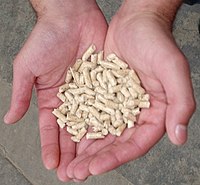
Photo from wikipedia
Co-products from the food and agricultural industries can potentially be used to replace concentrated high value grain crops in diets for sows. The co-products are typically high in fiber and… Click to show full abstract
Co-products from the food and agricultural industries can potentially be used to replace concentrated high value grain crops in diets for sows. The co-products are typically high in fiber and with diverse composition. Energy digestibility and utilization are generally high in sows fed fiber-rich feedstuff, but nitrogen digestion and utilization may be compromised. The purpose of this study was to quantify the apparent total tract digestibility (ATTD) of nutrients and utilization of energy and nitrogen in empty non-lactating sows fed six different fiber-rich co-products (FRCP). Brewers spent grain (BSG), pea hull (PH), potato pulp (PP), pectin residue (PR), sugar beet pulp (SBP) and seed residue (SR) were mixed into a basal diet (BD) with as high an inclusion level as possible, or the BD was fed solely to 8 empty sows in a Youden square incomplete cross-over design. The collection period consisted of a total collection period of five days, of which two days were in a respiration chamber. The sows had a gross energy (GE) intake between 28.5 and 42.3 MJ/d; greatest for the PH fed sows and lowest for the PP fed sows. The ATTD of dry matter, organic matter, GE and N did not differ among the BD and the PH and SBP fed sows, while the ATTDs of all nutrients and energy were intermediate for PR and BSG lowest in SR fed sows (P < 0.01). The differences were caused by variation in digestible and metabolizable energy content of the FRCP ingredients, which was lowest for SR, intermediate for PR followed by BSG and greatest for SBP, PP and PH (P < 0.001). Total heat production (HP) did not differ among treatments but the non-activity related HP was highest in SR fed sows and lowest in PH and SBP fed sows (P < 0.05). Retention of energy was greatest following the PH and BD (7.42 and 2.19 MJ/d, respectively), intermediate for PP, SBP and BSG fed sows (-0.22 to -0.69 MJ/d) and lowest for the PR and SR fed sows (-4.26 and -6.17 MJ/d, respectively) (P < 0.001). From a sow feeding perspective, SBP and PH have the potential to partly replace high value grain crops due to high ATTD of all nutrients and because sows can efficiently utilize energy and protein. In contrast, SR and PR show low ATTD of nutrients and energy, thereby compromising the nutritive value. Potato pulp and BSG also have the potential to be included in sow diets, but caution should be taken because of compromised N utilization and thereby increased environmental impact.
Journal Title: Journal of animal science
Year Published: 2023
Link to full text (if available)
Share on Social Media: Sign Up to like & get
recommendations!